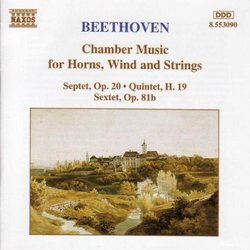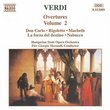| All Artists: Ludwig van Beethoven Title: Beethoven: Chamber Music for Horns Winds & Strings Members Wishing: 0 Total Copies: 0 Label: Naxos Original Release Date: 1/1/1995 Re-Release Date: 7/18/1995 Genre: Classical Styles: Chamber Music, Historical Periods, Classical (c.1770-1830) Number of Discs: 1 SwapaCD Credits: 1 UPC: 730099409025 |
Search - Ludwig van Beethoven :: Beethoven: Chamber Music for Horns Winds & Strings
 | Ludwig van Beethoven Beethoven: Chamber Music for Horns Winds & Strings Genre: Classical
|
Larger Image |
CD DetailsSimilar CDs |
CD ReviewsGreat Chamber Music Collection! Jeffrey P Cook | Northport, AL United States | 06/18/2000 (5 out of 5 stars) "This recording becamse an obsession of mine. I had heard of it's existence but could never find it until about a month ago. I was so excited, being a horn player, to see the Quintet for 3 horns, oboe and basson, since it is rarely recorded. This is the highlight of the recording for me, it showcases Beethoven's absolute brilliance in writing for Winds, particularly the horn. The sextet is another favorite piece of mine, this recording being a perfect example of impeccable balance between the horns and strings. The low horn player needs to have absolute agility for this piece, and this recording shows how it is done! The Septet is played wonderfully also, but to tell the truth, is not really one of my favorite pieces. This recording is perfect for it's diversity in repetoire and the price cannot be beat!" Genius Made Manifest Jasper | New England | 04/06/2006 (5 out of 5 stars) "Naxos' "Beethoven; Music for Horns Winds and Strings" is a phenomenal experience. The bubbling, piping, singing, nature of this music, and these instruments, is truly a delight, and whilst the mood is predominantly gleeful, amidst this joy there also lurks profundity, romance, serenity, and pathos. Beethoven did not treat these pieces as mere wallpaper music, but rather as symphonies in miniature; small orchestral works into which he poured the whole of his genius. These pieces move and progress with all the finesse, complexity and guile that we could hope for from Beethoven, and the excellent work of these first-rate musicians brings them bursting to life. The intimacy and passion of the chamber is here, alongside the sweeping movement, variation and grandness of the symphony. Unlike a previous reviewer, I find the Septet to be profoundly delightful and clever, and am willing to bet that the lion's share of listeners will join me in marveling at its beauty and ingenuity; the opening 1:40 of the first movement is particularly breathtaking. This is to take nothing from the quintet and sextet, which are luminous and thoroughly engaging as well. Sound quality is smooth and rounded, an effect (enhanced by the given instrumentation), which brings to mind the qualities of premium vinyl. The instruments don't seem to have been recorded at particularly close range, giving the listener the effect of sitting midway back in a medium-sized hall. At times, for me at least, these pieces recall Mozart's "Gran Partita." And whilst the Mozart is focused more so upon the winds, I believe admirers of one will find much to like about the other. A superb and inexpensive recording of the "Gran Partita" can be found on the Telarc label, featuring Mackerras conducting the Orchestra of St. Luke's. I don't fear the risk of hyperbole when I advise music lovers and admirers of Beethoven that experiencing these pieces, be it through this fine recording, or some other, is nothing short of essential." Beethoven's Septet on Naxos Robin Friedman | Washington, D.C. United States | 02/23/2009 (4 out of 5 stars) "During his lifetime, Beethoven's early Septet, opus 20, became one of his most popular compositions. The Septet was played incessantly in its original form and in arrangements, some of them unauthorized, for other instruments. The work achieved such popularity that Beethoven remarked that he wished it had been burned.
Today the work is little heard. It is known primarily to lovers of winds and horns. There are surprisingly few reviews of the various versions of the Septet available here on Amazon. Critics also have not been kind to the Septet. The work dates from 1800, at around the time of the first symphony, opus 21. Beethoven was struggling to make a name for himself in Vienna. The Septet was intended to be a crowd-pleaser and in that it succeeded admirably. The work is tuneful, lovely, and immediately accessible. It is salon music, similar to the divertimento of Mozart. Critics tend to fault the work for being no more than the charming, light music that it is. The verdict is much too harsh as the Septet remains a beautiful work that will reward hearing. The Septet in E Flat Major is in six movements and scored for violin, viola, cello, double bass, clarinet, horn, and bassoon. It receives a spirited performance on this early (1994) Naxos release. The individual musicians are mentioned, but the liner notes tell nothing about them or the ensemble. There is an aura of spontaneity and relaxation in the music-making. Listeners who know Beethoven's piano sonatas well will recognize the theme of the third movement of the Septet. Even earlier in his career, Beethoven had used it as the finale of his "easy" piano sonata, opus 49 no. 2. The swing and lightness of the theme is much more appealing in the Septet than in the earlier piano work. The fourth movement of the Septet also became famous in its day for its songlike theme and set of five variations. It is unclear whether Beethoven used a folk song as his theme, or whether a song was subsequently written around Beethoven's music after it attained great popularity. The Septet begins with a lengthy opening movement with a slow, dramatic introduction followed by a lively allegro in which the winds and strings are integrated. The second movement, an adagio, features a clarinet solo whose theme is picked up by the violin. The work also includes a quick, vigorous scherzo and a march like finale which works its way to a rapid, happy conclusion. The remaining two works on this CD also date from early in Beethoven's career and are even less familiar than the Septet. The Sextet in E Flat Major, opus 81b dates from 1794 and 1795. It is scored for two horns, two violins, viola, and cello. The much more famous opus 81a is Beethoven's Les Adieux piano sonatas. (Confusion in the opus numbers resulted because the works were submitted to different publishers.) Beethoven published this work in 1810 together with another wind sextet, opus 71, not included on this CD. As Lewis Lockwood states in his biography, (at 377) Beethoven wrote to his publisher that this piece was "one of my earlier works, written in one night, and one can only say that it is written by an author who has brought out at least some better works." Be that as it may, the work is pleasant and worth knowing. It is in three movements, with a long opening allegro, a short adagio, and a humourous rondo finale. It is most notable for the prominent role it gives to the horn duo. The final work on this CD is the Quintet for three horns, oboe and bassoon, H. 19 which dates from 1795-1796. Unfortunately, much of this work was lost, and the version we have on this CD is a reconstruction that dates from 1862. This work thus is of limited interest. For those wanting to expand their knowledge of Beethoven, this CD offers an excellent opportunity to get to know the once-famous Septet opus 20 and the obscure Sextet opus 81b both of which are scored for horns, winds and strings. Robin Friedman" |

 Track Listings (12) - Disc #1
Track Listings (12) - Disc #1
